词向量(词嵌入,Word Embedding)已经比较熟悉了,但还是整体梳理一下比较好。不再详细介绍它的背景和简介,而是将能想到的细节进行整理说明。
语言模型
语言模型的任务定义:对于语言序列$w_1,w_2,w_3,…,w_n$,语言模型就是计算该序列的概率,即$P(w_1,w_2,w_3,….,w_n)$。从机器学习角度来看,语言模型就是对语句的概率分布进行建模。简单来说,可以用语言模型来比较两个语句哪个更加正常,如 $P(\text{I am Light}) > P(\text{Light I am})$。由概率公式可得:
$$P(w_1,w_2,w_3,….,w_n) = P(w_1)\cdot P(w_2 | w_1) \cdot P(w_3 |w_1, w_2)\cdot \ … \ P(w_n|w_1,w_2,…w_{n-1})$$
在统计学领域,语言模型通常是使用n-gram语言模型,即使用size为n的window对序列切分建模,这里不再展开。
2003年,Bengio发表了神经网络语言模型(NNLM)论文[1],其网络结构如下图所示: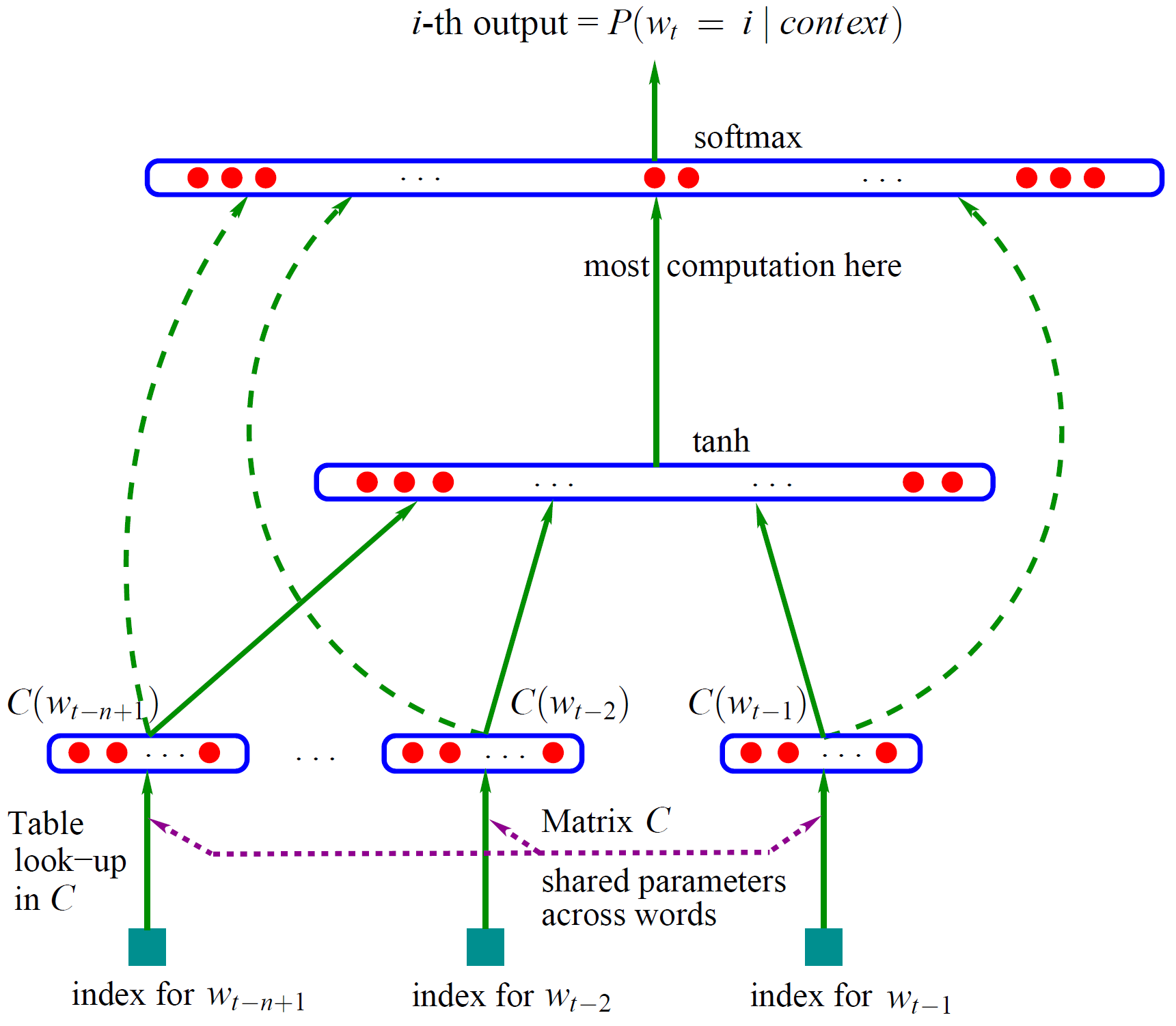
NNLM包含输入层,隐层,输出层三层神经网络,首先来看输入层,将单词$w_t$的上文(前n个单词)使用one-hot形式表示,并乘以矩阵$C$(跟据one-hot形式可发现是查表操作)。然后将得到的向量拼接在一起得到 $[C(w_{t-n+1}), …C(W_{t-2}), C(W_{t-1})]$ ,其作为隐层的输入。隐层的激活函数为tanh。最后输出层使用Softmax进行词汇表 $V$ 上的分类。矩阵$C$初始是随机初始化的,通过NNLM任务发现,学习后的矩阵$C$是一个密集且包含语义的词向量矩阵。通过one-hot进行相乘可得到每个单词对应的词向量。
one-hot向量长度为词汇表$V$维向量,嵌入维度m可自行设定。在cs224n课程中,矩阵$C$及隐层权重$W$都用来表示词嵌入,后者被成为上下文向量。 在吴恩达课程中,嵌入矩阵即为矩阵$C$。
通过NNLM任务,作为副产品的词向量效果良好,进而将其发扬光大。
Word2vec
Word Embedding的常用技术:word2vec主要任务目标就是为了训练得到词向量,而不再是NNLM的任务。word2vec包含两个模型CBOW,Skip-gram。word2vec是由两篇论文[2][3]完成的,第一篇论文提出了两个模型,第二篇论文提出了两个训练技巧,使训练更加有效可行。
模型细节
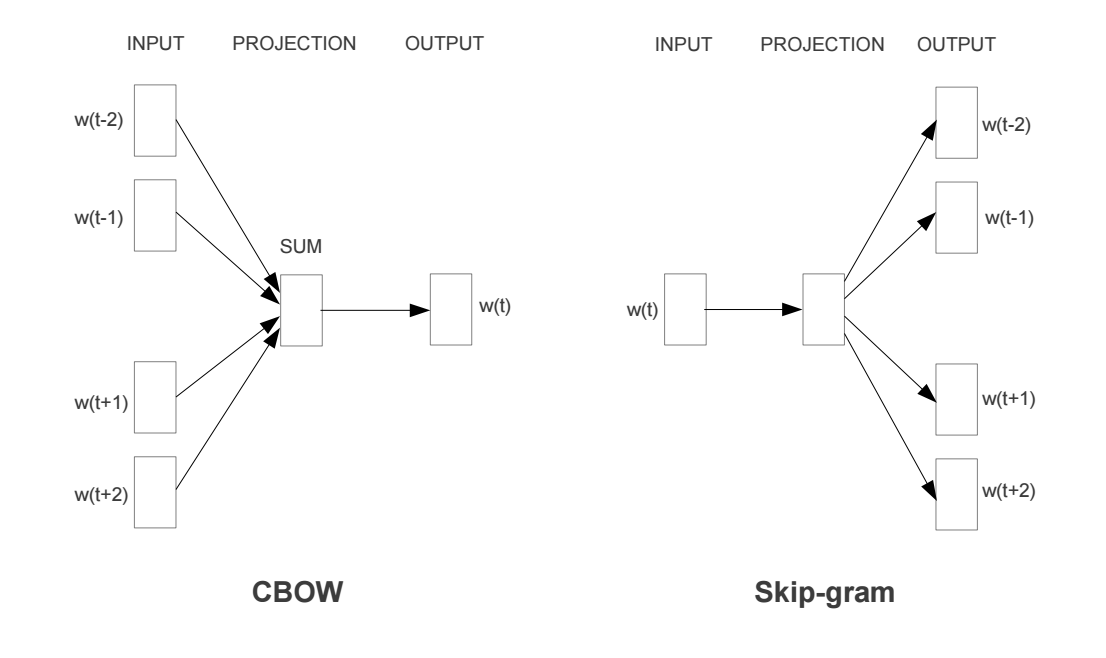
CBOW模型是将中心词的上下文作为输入来进行预测,而Skip-gram是根据中心词来预测其上下文单词。二者其实差不多。现在以Skip-gram为例来介绍下细节[4]。
我们想要训练一个神经网络,抽取语句中的一个中间词来作为输入单词,然后随机选择’临近’的一个单词(‘临近’即超参数window size,通常选择5,即中心词前后各五个单词)。网络的输出概率应该为那些比较相关的单词。比如输入单词为”Soviet”,那输出结果 “Union” 和 “Russia”的概率应该高于其它不相关的单词。
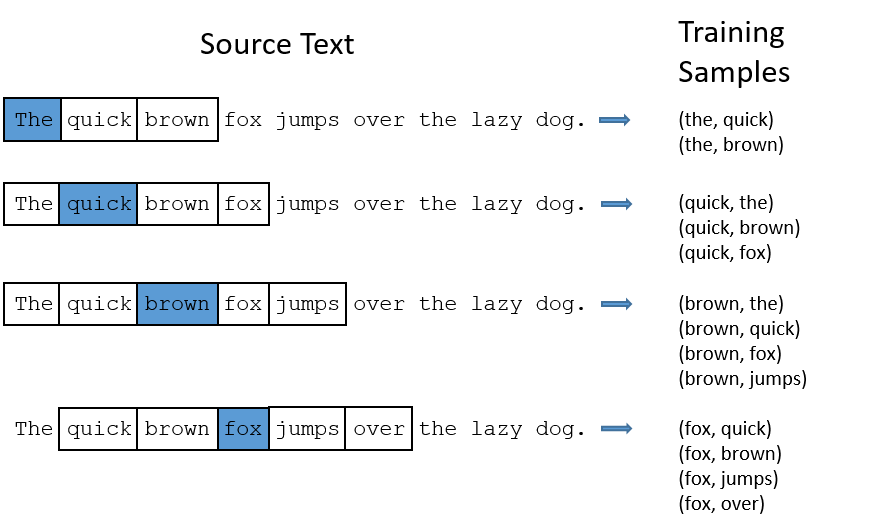
网络应该能从单词组的共现次数上学习到统计信息。比如词组(“Soviet”, “Union”)出现是高于(“Soviet”, “Sasquatch”),当网络在训练完成后,输入”Soviet”得到的结果中,”Union” 或 “Russia” 的概率应高于 “Sqsquatch”。
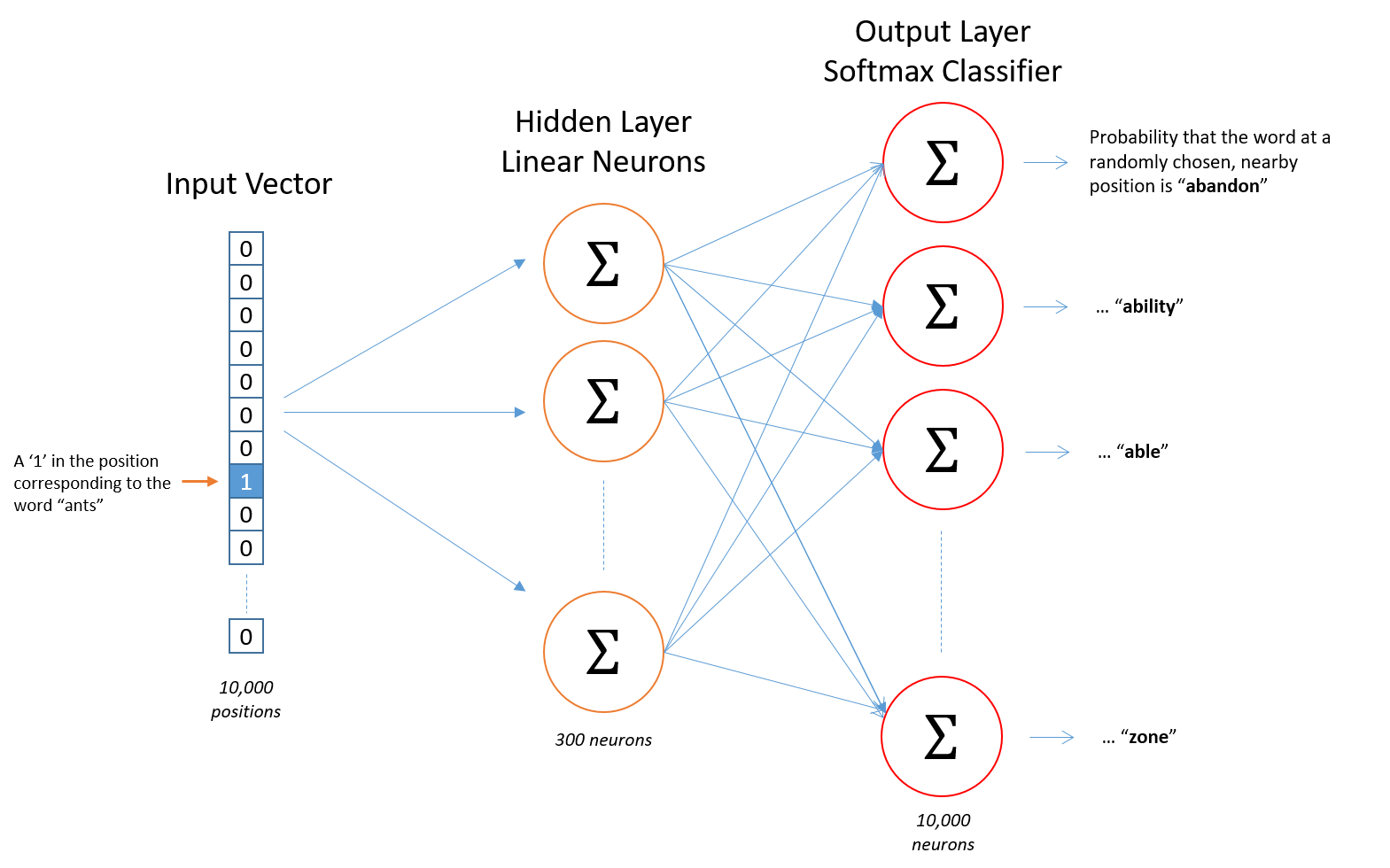
加入词汇表长度为10000,首先使用one-hot形式表示每一个单词,经过隐层300个神经元计算,最后使用Softmax层对单词概率输出。每一对单词组,前者作为x输入,后者作为y标签。
隐层细节
假如我们想要学习的词向量维度为300,则需要将隐层的神经元个数设置为300(300是Google在其发布的训练模型中使用的维度,可调)。
隐层的权重矩阵就是词向量,我们模型学习到的就是隐层的权重矩阵。

之所以这样,来看一下one-hot输入后与隐层的计算就明白了。

当使用One-hot去乘以矩阵的时候,会将某一行选择出来,即查表操作,所以权重矩阵是所有词向量组成的列表。
输出层细节
Softmax细节不再阐述,其能将输出进行概率归一化。
注意,神经网络并没有学习到输出相对于输入的偏移量。比如,在我们的语料库中,’York’每次前面都有’New’这个单词,所以,从训练数据角度来讲,’New’与’York’附近的概率为100%,但在’York’附近随机取10个单词,那概率就不再是100%了。
问题
假如使用词向量维度为300,词汇量为10000个单词,那么神经网络输入层与隐层,隐层与输出层的参数量会达到惊人的300x10000=300万!训练如词庞大的神经网络需要庞大的数据量,还要避免过拟合。因此,Google在其第二篇论文中说明了训练的trick,其创新点如下:
- 将常用词对或短语视为模型中的单个”word”。
- 对频繁的词进行子采样以减少训练样例的数量。
- 在损失函数中使用”负采样(Negative Sampling)”的技术,使每个训练样本仅更新模型权重的一小部分。
子采样和负采样技术不仅降低了计算量,还提升了词向量的效果。
对频繁词子采样

在以上例子中,可以看到频繁单词’the’的两个问题:
- 对于单词对(‘fox’,’the’),其对单词’fox’的语义表达并没有什么有效帮助,’the’在每个单词的上下文中出现都非常频繁。
- 预料中有很多单词对(‘the’,…),我们应更好的学习单词’the’
Word2vec使用子采样技术来解决以上问题,根据单词的频次来削减该单词的采样率。以window size为10为例子,我们删除’the’:
- 当我们训练其余单词时候,’the’不会出现在他们的上下文中。
- 当中心词为’the’时,训练样本数量少于10。
采样率(Sampling rate)
使用 $w_i$来表示单词,$z(w_i)$来表示单词的频次。采样率是一个参数,默认值为0.001。$P(w_i)$ 表示单词保留的概率:
$$P(w_i)=(\sqrt{\frac{z(w_i)}{0.001}} +1) \cdot \frac{0.001}{z(w_i)}$$
该函数的图像为: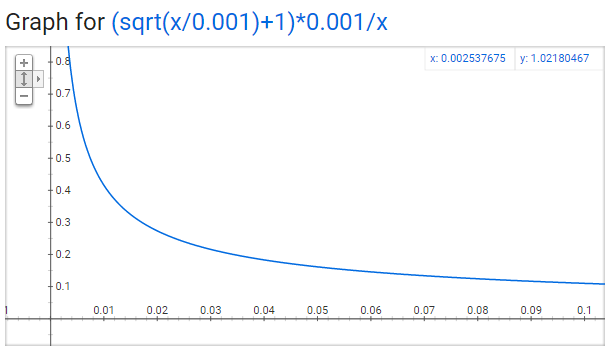
可以发现随着频次x的增加,其保留的概率越低。关于此函数有三个点需要注意:
- $P(w_i) = 1.0$(100%保留),对应的 $z(w_i)<=0.0026$。(表示词频大于0.0026的单词才会进行子采样)
- $P(w_i) = 0.5$(50%保留),对应的 $z(w_i)=0.00746$。
- $P(w_i) = 0.033$(3.3%保留),对应的 $z(w_i)=1.0$。(不可能)
负采样(Negative Sampling)
训练一个网络是说,计算训练样本然后轻微调整所有的神经元权重来提高准确率。换句话说,每一个训练样本都需要更新所有神经网络的权重。
就像如上所说,当词汇表特别大的时候,如此多的神经网络参数在如此大的数据量下,每次都要进行权重更新,负担很大。
在每个样本训练时,只修改部分的网络参数,负采样是通过这种方式来解决这个问题的。
当我们的神经网络训练到单词组(‘fox’, ‘quick’)时候,得到的输出或label都是一个one-hot向量,也就是说,在表示’quick’的位置数值为1,其它全为0。
负采样是随机选择较小数量的’负(Negative)’单词(比如5个),来做参数更新。这里的’负’表示的是网络输出向量种位置为0表示的单词。当然,’正(Positive)’(即正确单词’quick’)权重也会更新。
论文中表述,小数量级上采用5-20,大数据集使用2-5个单词。
我们的模型权重矩阵为300x10000,更新的单词为5个’负’词和一个’正’词,共计1800个参数,这是输出层全部3M参数的0.06%!!
负采样的选取是和频次相关的,频次越高,负采样的概率越大:
$$P(w_i) = \frac{f(w_i)^{3/4}}{\sum_{j=0}^n(f(w_j)^{3/4})}$$
论文选择0.75作为指数是因为实验效果好。C语言实现的代码很有意思:首先用索引值填充多次填充词汇表中的每个单词,单词索引出现的次数为$P(w_i) * \text{table_size}$。然后负采样只需要生成一个1到100M的整数,并用于索引表中数据。由于概率高的单词在表中出现的次数多,很可能会选择这些词。
分层Softmax
Skip-gram 代码实现
Skip-gram的实现有多种方式,比如很多软件包(gsim)已经收录了,可以直接调用。Skip-gram模型并不复杂,网络仅有一个隐层,使用Keras实现也非常简单,但是自己手写实现更更好理解一些。这里讲下自己的实现。主要参考Tensorflow word2vec模型,该实现封装数据集及推理(analogy)等内容,但对神经网络的定义、负采样、NCE损失函数等内容的,虽然并不都是完全底层实现,但对深入理解还是很有帮助的。数据集采用的是20newsgroups,这个数据集有个博士处理后的版本(去除了停用词the等)。20newsgroups数据还是比较粗糙的,整个实现比较随意,源jupyter及训练数据也就没有上传github,但对模型理解还是有帮助的。
加载数据
1 | def load_data(): |
使用子采样方式生成训练数据1
2
3
4
5
6
7
8
9
10
11
12
13
14
15
16
17
18
19
20
21
22
23
24
25
26
27
28
29def generate_samples(corpus, vocab, vocab_freq):
"""使用子采样生成数据"""
LEN = len(corpus)
rate = 0.001
samples = []
for i,center_word in enumerate(corpus):
# 非词汇表词过滤
if i-2<0 or i+2>LEN-1 \
or center_word is None \
or center_word == vocab['.']:
continue
else:
condedate_words = [center_word, corpus[i-1], corpus[i-2], corpus[i+1], corpus[i+2]]
condedate_words = [word for word in condedate_words if word is not None]
freqs = np.array([vocab_freq[word] for word in condedate_words])
p_keeps = (np.sqrt(freqs/rate) + 1) * rate / freqs
p_keeps[p_keeps>1] = 1
if random.random() > p_keeps[0]:
# center_word 子采样
# print('center_word %d 舍弃' % center_word)
continue
else:
# target_word 子采样
sampled_words = [(center_word, condedate_words[i+1]) for i,p in enumerate(p_keeps[1:]) if random.random()<p]
samples.extend(sampled_words)
return samples
子采样需要注意,论文中使用的采样公式与cs224n课程中不一样,但都可以实现,别忘记对数值进行截断,概率最大为1。
skip-gram 网络定义
1 | emb_dim = 300 |
网络定义基本手写copy github官方模型,在这可以看到NCE loss是如何计算,一般理解负采样是在反向传播简化计算,其实也是直接在前向进行计算简化,这点比其它博文教程要好。
训练
训练就比较简单,直接上就行。
不过即使使用了子采样,the的中心词数据也在30W+,调参不如直接删除~ 用博士处理后的数据训练效果会好一些,但那个数据的分词也挺烂的~
2
3
4
5
6
reverse_vocab = {v:k for k,v in vocabulary.items()}
center_words = [x for (x,y) in samples]
target_words = [y for (x,y) in samples]
train(center_words, target_words, vocabulary, reverse_vocab, list(counts))
总之,skip-gram的效果还是可以看到的。
参考
[1] A Neural Probabilistic Language Model
[2] Distributed Representations of Words and Phrases and their Compositionality
[3] Efficient Estimation of Word Representations in Vector Space
[4] cs224n: Word2Vec Tutorial - The Skip-Gram Model
[5] word2vec Parameter Learning Explained
[6] [Tensorflow word2vec模型]
[7] 20newsgroups数据集